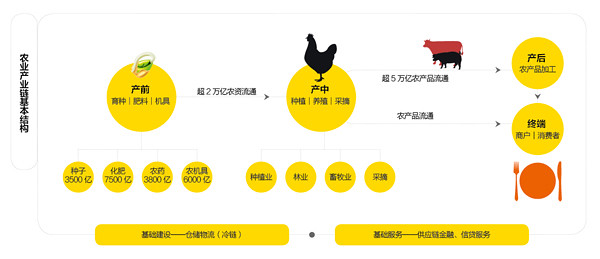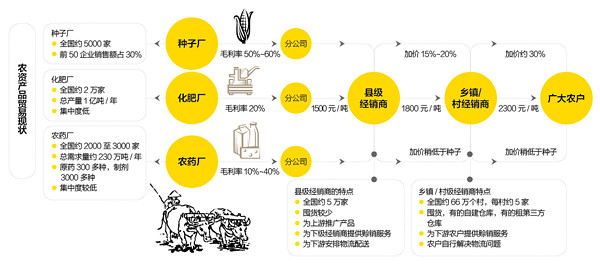
In 2015, the central document first noted that "strong support for e-commerce, logistics, trade, finance and other enterprises involved in agriculture-related e-commerce platform, comprehensive model of developing e-commerce in rural areas". However, as early as in front of the Government, has consistently led the Internet industry has begun to act, using large data, cloud platform, the IOT Internet technologies, such as financial, logistics, and other community resources to achieve agricultural industrial chain to the Middle, enhance the efficiency of production and circulation of the new platform has a lot of agriculture. Here, what we call was aimed at agricultural and farm produce trading platform.
When we want to use the Internet thinking optimization or redefine a wide range of traditional industries, have to overlook the complete industry chain structure, each functions assumed by the participant and their cost profit situation. If the Internet platform is unable to provide service beyond the existing dealers, so further development may be to rely on outrageous scalping.
First, basic structure of agricultural industry chain
B2B Internet platform of agriculture at present there are three main categories:
1.B2B agricultural e-commerce platform
Agricultural supplies industry as a whole is on the rise, and products are mainly divided into seeds (marketing space of about 350 billion yuan), fertilizers (750 billion yuan), pesticides (380 billion yuan), agricultural (600 billion yuan) in four categories, this type of agricultural e-commerce platform trying to bring lower-priced agricultural products to farmers, County and village levels in the process of removing agricultural trade dealers.
2.B2B agricultural products e-commerce platform
In 2013, the scale of trade in China exceeded 5 trillion yuan, during the entire trading, logistics, financial services is still very weak, and there is a serious problem of price is not transparent.
3.B2B food distribution platform
In 2014, the restaurant industry's annual revenue of more than 3 trillion yuan, food purchases to reach 800 billion yuan. Small and medium sized restaurant has a lot of pain, such as purchasing a small amount of bargaining cannot be obtained, purchasing human resources expenditures, as well as the possibility of gray income expenditure, purchase food quality cannot be guaranteed, and so on.

Second, the current situation of trade in agricultural products
Agricultural marketing environment characteristics:
Farmer: farmer's low access rates, secondary Internet access there is a strong demand, more familiar with the village, leading to interact more.
Commodity risk: seeds, pesticide products have a certain risk, if you sell fake seeds, probability of compensation for 100%, pesticides also have a similar situation.
Warehouse logistics: infrastructure is far from perfect, last mile logistics in rural areas lack more by farmers to solve the transportation problem.
Credit requirements: township-level dealers will often provide credit service to farmers, relying on acquaintance relationships to maintain repayments and early agricultural e-commerce platform to provide credit services, distributors still have a competitive advantage.
Credit: national lending strong support to agriculture, and the financing needs of farmers is very strong, but rural family's normal credit approval rate was only 27.6%, far below the national average of 40.5%. Farmers ' loan default risk is high, even if the land and home foreclosures also collection hard.

Third, agricultural trade situation
In 2013, China's agricultural volume of more than 5 trillion yuan. In 2014, the restaurant industry's annual revenue of more than 3 trillion yuan, food purchases to reach 800 billion yuan.

1.B2B characteristics of the agricultural product market environment
Merchants: agricultural trade links in various bases, 70% for the self-employed, 30% for small businesses. Because the price of each agricultural products according to type, amount of purchase, relationship pricing, transaction prices are very opaque.
Logistics: cold chain infrastructure is not perfect, in the course of trade as a whole dish losses cost 20% ~ 30%. 5000 square meter warehouse rent of about 1.5 million Yuan a year, most businesses rely on their own vehicles into the ship, laden by a Gold Cup for 10 ~ 15 restaurants in demand, and a value between 5000-10,000 yuan; Sy LAU using the Internet to tap the country s
Financial: primary, secondary distribution market can provide credit services and raw materials, monthly cycle, but Internet is providing similar services. Broker 90% seasonal financing needs of 100,000-500,000 yuan, 500,000 yuan and sales area dealer 70% ~ 2 million yuan of seasonal financing needs, national policy on lending to agricultural businesses are very positive, but due to the lack of real estate as collateral in credit access conditions cannot be achieved, leading dealers lack the support of financial institutions.
2.B2B food supply platform characteristics
They are mainly downstream distribution service in the restaurant, restaurants for centralized purchasing to gain bargaining power, while providing logistics services, so as to reduce costs and raw materials. Well-known platform have beautiful food, chain farmers, chefs mesh, peasant women, the excellent service good, food baskets, Hotel Union, but the competition is very fierce, scalping is serious.
Product features: very opaque, food quality is difficult to control.
Restaurant features: small restaurant for purchases of small, no bargaining advantage purchases will consume a lot of manpower, vehicles cost composition of different procurement gets rebates, low levels of information, procurement method is hard to break.
Traditional distribution: pop-oriented, private van services per day 7 ~ 8 restaurants, Maori 1 ~ 30,000 yuan a month, can provide credit services for restaurants.
Solution programme: B2B food material distribution platform solution programme similar degrees high, daily at 12 o'clock zhiqian summary 1000 home restaurant thousands species SKU orders-platform buyer in dealer at procurement-sent to sorting center (often for 5000 square meters warehouse)-morning 4 to 6 points by 200 name distribution personnel (average salary 3500 ~ the 5000 Yuan/months) distribution-package loading-early peak Qian sent to the restaurant.
Warehouse logistics: 1000 restaurant distribution, requires a 5000 sqm warehouse (rent of 1.5 million/year) for distribution, a Gold Cup may contain 10-15 stock, value of 5000 to 10,000 yuan per car.
Return: return if the restaurant, the platform is responsible for replenishment. If the service is good enough, restaurant turnover can be reduced to less than 5%.
Credit services: B2B food distribution platform yet provides credit services to restaurants, while traditional dealers will be providing credit services.
Four, foreign agricultural business reference
1. the United States agricultural merchant
United States farmers on the Internet's main activities are information gathering, financial management, e-procurement and sale of agricultural products. In 2000, the United States farm online transactions for $ 665 million, total farm trading 0.33%. Online purchases of $ 378 million, mainly purchased products such as machinery and equipment, agricultural production and feed, in particular means of online purchases have accounted for 35% of the total purchases. Net sales of us $ 287 million of agricultural products, including 66% for animal products, 34% for agricultural products.
2. Japan agricultural merchant
2000, Japan Government developed agricultural information strategy, promoted agricultural circulation, so also developed has General of agricultural orders, and sent, and settlement standard, and on wholesale market of electronic trading system for has transformation, Japan agricultural collaborative combination website also is responsible for introduced agricultural production technology and market market, last will formed has large integrated online trading market, and agricultural electronic exchange, and specifically of agricultural online store and integrated online supermarket, several class main of agricultural electric business form. Specialized agricultural product outlets are competitive, because it will directly connect both sides, they are able to ensure product freshness and reducing the costs of intermediaries.
3. the Korea agricultural merchant
In 2004, Korea has five sizeable agricultural business, Korea agriculture information centre free of charge for farmer training in business skills, a few years later Korea reached more than 8,000 farmers home page more farmers on the home page to publish their products, negotiate directly with the demand side. Korea electronic channels to increase 18%, 2006 agricultural e-commerce turnover of 2 billion won. 2008 Korea agricultural products and beverages online turnover up 1.502 trillion won, accounting for 8.3% of all online transactions.
No comments:
Post a Comment